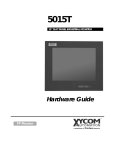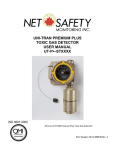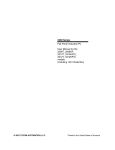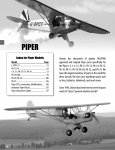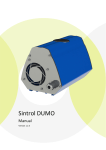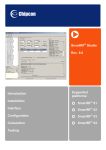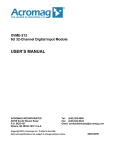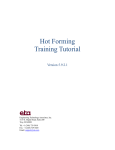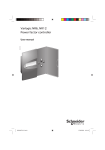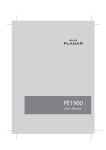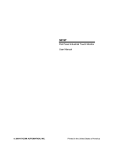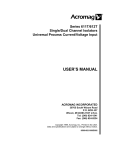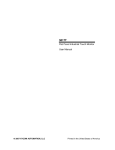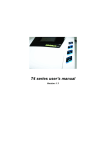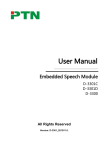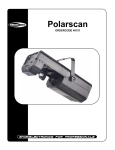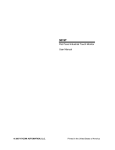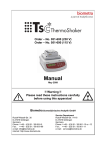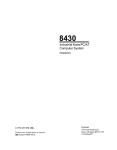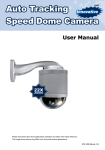Download ST1210
Transcript
ST1210 FLAT PANEL INDUSTRIAL MONITOR FLAT PANEL INDUSTRIA Hardware Guide Revision Description A Manual released B Preliminary revision released for new controller board C Manual updated Xycom Automation Part Number 141284(C) Date 12/01 06/02 06/02 Trademark Information Xycom Automation is a trademark of Xycom Automation, Inc. Brand or product names may be registered trademarks of their respective owners. Windows is a registered trademark of Microsoft Corporation in the United States and other countries. Copyright Information This document is copyrighted by Xycom Automation Incorporated (Xycom Automation) and shall not be reproduced or copied without expressed written authorization from Xycom Automation. The information contained within this document is subject to change without notice. Xycom Automation does not guarantee the accuracy of the information. United States FCC Part 15, Subpart B, Class A EMI Compliance Statement: NOTE: This equipment has been tested and found to comply with the limits for a Class A digital device, pursuant to part 15 of the FCC Rules. These limits are designed to provide reasonable protection against harmful interference when the equipment is operated in a commercial environment. This equipment generates, uses, and can radiate radio frequency energy and, if not installed and used in accordance with the instruction manual, may cause harmful interference to radio communications. Operation of this equipment in a residential area is likely to cause harmful interference in which case the user will be required to correct the interference at his own expense. For European Users: WARNING This is a Class A product. In a domestic environment this product may cause radio interference in which case the user may be required to take adequate measures. INSTALLATION: Electromagnetic Compatibility WARNING The connection of non-shielded equipment interface cables to this equipment will invalidate FCC EMI and European Union EMC compliance and may result in electromagnetic interference and/or susceptibility levels which are in violation of regulations which apply to the legal operation of this device. It is the responsibility of the system integrator and/or user to apply the following directions which relate to installation and configuration: All interface cables must include shielded cables. Braid/foil type shields are recommended. Communication cable connectors must be metal, ideally zinc die-cast backshell types, and provide 360 degree protection about the interface wires. The cable shield braid must be terminated directly to the metal connector shell, ground drain wires alone are not adequate. Protective measures for power and interface cables as described within this manual must be applied. Do not leave cables connected to unused interfaces or disconnected at one end. Changes or modifications to this device not expressly approved by the manufacturer could void the user's authority to operate the equipment. Table of Contents 1. Product Overview.........….......................................................................................... 1-1 Product Features…………………………………………….……………………………………1-1 Standard ST1210 Features…………………………………………………………………….1-1 Parts List…………………………………………………….……………………………………1-1 Standard ST1210 Parts List…………………………………………………………………...1-1 Manual Overview…………………………………………….…………………………………..1-2 Text Conventions Used in this Manual …………………….……………………………………1-2 Product Dimensions ……………………………………….…………………………………….1-3 Front Panel Controls …………………………………………….……………………………1-3 Product Specifications and Ratings……..………………….……………………………………1-4 Environmental……...…….……………………………………………………………………1-4 Electrical ……………………………………………………………………………………...1-4 Front Panel/Enclosure .......…….…………………………….…………………………………..1-4 Regulatory Compliance ...………………………………...…………………………………..1-4 Safety Agency Approvals ………………….…………………………………………………1-4 2. Installation ..........................................…................................................................... 2-1 Environmental Considerations …….……….……………………………………………………2-1 System Power …………...……………………………………………………………………2-1 Excessive Heat …………..….…………..……………………………………………………2-1 Electrical Noise ...…………...…………..……………………………………………………2-2 Line Voltage Variation …...……………..……………………………………………………2-2 Location and Enclosure …………...…….……………………………………………………2-2 Panel Installation …………………….……..……………………………………………………2-3 Panel Mounting Dimensions ...…………..……………………………………………………2-3 3. Monitor Settings ..............................................….......................................................3-1 Mode and Image Adjustment ……………....……………………………………………………3-1 Video Modes Supported ………………………………………………………………………3-1 Onscreen Display (OSD) Functions …………..…………………………………………………3-1 Front Panel Controls ……….…………………………………………………………………3-1 Main OSD menu …………...…………………………………………………………………3-2 Color Submenu …………….…………………………………………………………………3-2 RGB Submenu ……..………………………………………………………………………3-2 Position Submenu ………….…………………………………………………………………3-3 Image Submenu ………………………………………………………………………………3-3 Miscellaneous Submenu …...…………………………………………………………………3-3 OSD Position Submenu……...……………………………………………………………3-3 4. Hardware ..............................................…...............................................…………....4-1 VGA Input Connector Pin Out …………………...…………………………………………….4-1 Back Light Replacement Procedure ……………...…………………………………………….4-1 Appendix A: Reaching Technical Support……………...…...………………………………...A-1 1. Product Overview Xycom Automation industrial monitors meet the rigorous requirements of the plant floor with high-resolution flat panel displays in a rugged housing with an optional resistive membrane touchscreen. The ST1210 flat panel monitor delivers crisp, bright text and graphics with a low current draw, and it fits into panels that CRTs cannot. The ST1210 is self-contained, requiring only to be panel mounted in an appropriate enclosure and connected to 120/240 VAC and VGA source. Product Features Standard ST1210 Features • • • • • • • • • • • • • 12.1" bright (200 Nit), easy-to-read, high contrast (150:1), color (18 bit/262,144 colors) TFT flat panel display with SVGA (800x600) resolution Large viewing area and viewing angles (120° horizontal, 100° vertical) Operator input through an optional integrated high-performance (35 million touch) touchscreen Front panel controls with onscreen menus (lock switch on rear of units) Long-lasting (50,000 hour) backlight Hinged design for easy backlight field replacement Simple mounting Shallow mounting depth Up to 50 foot cables Optional 19" EIA rackmount adapter plate NEMA 4/12 front panel, when properly mounted UL and cUL recognized, CE marked Units ship with all necessary cables and software Parts List When you remove the ST1210 from its shipping carton, verify that you have the parts listed below. Save the box and inner wrapping in case you need to reship the unit. Standard ST1210 Parts List • • • • ST1210 unit. Ten-foot VGA cable. Ten-foot serial cable (touchscreen units only). Documentation and Support Library CD-ROM. In addition to containing this manual, this CD contains all drivers required by this unit (touchscreen drivers in the case of ST1210T units). 1-1 Manual Overview The manual is divided in the following chapters: • Chapter 1 – Product Overview • Chapter 2 – Installation • Chapter 3 – Monitor Settings • Chapter 4 – Hardware Text Conventions Used in this Manual Throughout this manual, certain terms are formatted in ways that indicate what type of object is being described. Some information is also segregated to draw attention quickly. Titles, labels, and messages are indicated by italic text. Computer filenames and text to be entered by the user will appear in a monospace font. Operator interfaces (such as the Start menu button) and keyboard keys (such as Enter) appear in a narrow bold typeface. Other text (such as the word Note ) is bold to emphasize it and draw your attention to it. Some text is segregated into Note , Caution, or Warning boxes. Notes contain extra information that may make the nearby text, especially the text just before the note, more understandable. Cautions contain information necessary to prevent damage to the hardware. Warnings contain information necessary to safeguard the operator. 1-2 Product Dimensions 10.50[266.70] 12.60[320.04] 3.00[76.20] in.[mm] Front Panel Controls The front panel controls, from left to right are Menu, Select, Increment, Decrement. Their use is detailed in Chapter 3— Monitor Settings. 1-3 Product Specifications and Ratings Environmental Operating Nonoperating Thermal 0°C to 50°C (32°F to 122°F) -20°C to 60°C (32°F to 122°F) Humidity 20% to 80% RH, noncondensing 20% to 80% RH, noncondensing Shock 15 g peak acceleration, 11 msec duration 0.006" peak-to-peak displacement 1.0 g maximum acceleration 30 g peak acceleration, 11 msec duration 0.015" peak-to-peak displacement 2.5 g maximum acceleration Sea level to 10,000 ft. (3,000 m) Sea level to 40,000 ft. (12,000 m) Vibration, 5-2000 Hz Altitude Electrical AC power: 100-240 VAC, 1.0 A, 60 Hz DC power: 24 VDC, 1 A Front Panel/Enclosure NEMA 4/12 Regulatory Compliance CE • EN 55022: Class A • EN 50082-2 • EN 60950 FCC • 47 CFR, Part 15, Class A Safety Agency Approvals UL • UL 60950 CUL • CSA-C22.2, #950 1-4 2. Installation Environmental Considerations The rugged design of the ST1210 allows it to be installed in most industrial environments. Refer to the electrical and environmental specifications and tolerances (pg. 1-4) for more detailed information. System Power It is a good practice to use isolation transformers on the incoming AC power line to the system. An isolation transformer is especially desirable in cases in which heavy equipment is likely to introduce noise onto the AC line. The isolation transformer can also serve as a step-down transformer to reduce the incoming line voltage to a desired level. The transformer should have a sufficient power rating (units of volt-amperes) to supply the load adequately. Proper grounding is essential to all safe electrical installations. Refer to the relevant federal, state/provincial, and local electric codes, which provide data such as the size and types of conductors, color codes and connections necessary for safe grounding of electrical components. The code specifies that a grounding path must be permanent (no solder), continuous, and able to safely conduct the ground-fault current in the system with minimal impedance (minimum wire required is 18 AWG, 1 mm). Observe the following practices: • Separate the power and ground (P. E., or Protective Earth) cable from signal cables at the point of entry to the enclosure. To minimize the ground wire length within the enclosure, locate the ground reference point near the point of entry for the plant power supply. • All electrical racks or chassis and machine elements should be Earth Grounded in installations where high levels of electrical noise can be expected. The rack/chassis should be grounded with a ground rod or attached to a nearby Earth structure such as a steel support beam. Connect each different apparatus to a single Earth Ground point in a "star" configuration with low impedance cable. Scrape away paint and other nonconductive material from the area where a chassis makes contact with the enclosure. In addition to the ground connection made through the mounting bolt or stud, use a one-inch metal braid or size #8 AWG wire to connect between each chassis and the enclosure at the mounting bolt or stud. Excessive Heat To keep the temperature in range, the cooling air at the base of the system must not exceed the maximum temperature specification (see pg. 1-4). Allocate proper spacing between internal components installed in the enclosure. When the air temperature is higher than the specified maximum in the enclosure (see pg. 1-4), use a fan or air conditioner to lower the temperature. 2-1 Electrical Noise Electrical noise is seldom responsible for damaging components, unless extremely high energy or high voltage levels are present. However, noise can cause temporary malfunctions that can result in hazardous machine operation in certain applications. Noise may be present only at certain times, may appear at widely spread intervals, or in some cases may exist continuously. Noise commonly enters through input, output, and power supply lines and may also be coupled through the capacitance between these lines and the noise signal carrier lines. This usually results from the presence of high voltage or long, close-spaced conductors. When control lines are closely spaced with lines carrying large currents, the coupling of magnetic fields can also occur. Use shielded cables to help minimize noise. Potential noise generators include switching components, relays, solenoids, motors, and motor starters. Refer to the relevant Federal, State/Provincial, and local electric codes, which provide data such as the size and types of conductors, color codes and connections necessary for safe grounding of electrical components. It is recommended that high- and low-voltage cabling be separated and dressed apart. In particular, AC cables and switch wiring should not be in the same conduit with all communication cables. Line Voltage Variation The power supply section of the unit is built to sustain the specified line fluctuations and still allow the system to function in its operating margin. As long as the incoming voltage is adequate, the power supply provides all the logic voltages necessary to support the monitor unit. Unusual AC line variations may cause undesirable system shutdowns. As a first step to reduce line variations, correct any possible feed problems in the distribution system. If this correction does not solve the problem, use a constant voltage transformer. The constant voltage transformer stabilizes the input voltage to the systems by compensating for voltage changes at the primary in order to maintain a steady voltage at the secondary. When using a constant voltage transformer, check that the power rating is sufficient to supply the unit. Location and Enclosure • • • • • • • • • Place the unit to allow easy access to the system ports. Account for the unit dimensions when selecting an installation location or enclosure (see pg. 1-3). You can maintain the NEMA 4 seal by mounting the unit in an approved enclosure that has a 14 gauge (0.075"/1.9 mm thick) steel or (0.125"/3.2 mm thick) aluminum front face. Place the unit at a comfortable working level. Mount the unit in an upright position, if possible. Consider locations of accessories such as AC power outlets and lighting (interior lighting and windows) for installation and maintenance convenience. Prevent condensation by installing a thermostat-controlled heater or air conditioner. Avoid obstructing the airflow to allow for maximum cooling. Place any fans or blowers close to the heat-generating devices. If using a fan, make 2-2 sure that outside air is not brought inside the enclosure unless a fabric or other reliable filter is used. This filtration prevents conductive particles or other harmful contaminants from entering the enclosure. • Do not select a location near equipment that generates excessive electromagnetic interference (EMI) or radio frequency interface (RFI) (equipment such as high-power welding machines, induction heating equipment, and large motor starters). • Do not place incoming power line devices (such as isolation or constant voltage transformers, local power disconnects, and surge suppressers) near the system. The proper location of incoming line devices keeps power wire runs as short as possible and minimizes electrical noise transmitted to the unit. • Make sure the location does not exceed the unit's shock, vibration, and temperature specifications (see pg. 1-4 for specifications). • Install the unit so it does not cause a hazard from uneven mechanical loading. • Incorporate a readily accessible disconnect device in the fixed wiring on permanently connected equipment. • Avoid overloading the supply circuit. Panel Installation This monitor should be mounted in and used where NEMA 4 and NEMA 12 type enclosures are employed. When mounted properly, the monitor meets or exceeds the sealing requirements set forth in the NEMA 4 and NEMA 12 specifications. The monitor uses "U"-shaped clips and a special gasket to achieve the proper seal. To install the monitor, make a cutout per the diagram below in one of the walls of your NEMA enclosure. Enclosures made of heavier gauge metal work better in that they won't deform or bend as easily when the monitor's sealing gasket is compressed. Next hold the monitor in place while you install the mounting clips. Tighten the clips in a cross pattern. This will help to develop an even pressure on the sealing gasket. Tighten the clips to the point were the back of the monitor's front bezel just begins to contact the front of the NEMA enclosure. Caution: Do not over tighten, because overtightening can cause damage to the monitor which can result in loss of seal integrity. Panel Mounting Dimensions 2-3 3. Monitor Settings Mode and Image Adjustment Not all video controllers produce exactly the same video output levels or the same timing. The ST1210 uses onscreen programming to make setup and adjustment easy. The menus are selected and the menu items are adjusted using the buttons located on the monitor front panel. These buttons are enabled or disabled by a rocker switch labeled SET UP located on the side of the monitor. This feature is provided to inhibit tampering once the monitor is in actual use. Turn the SET UP switch to the On position to enable set up and adjustment. Prior to adjusting your monitor you should initialize the display settings in the Windows control panel to the following choices: Colors: Vertical Refresh: Resolution: Monitor Type: 256 60 Hz 800 x 600 “Viewsonic 15” Note: The monitor type option is not available in Windows NT. Once the monitor is powered up, you can access the onscreen display (OSD) functions by pressing the menu button. After the menu appears, select the Auto Setup function following the directions given below. The monitor will automatically adjust to the incoming video signal. Then select the Image | Auto phase function or manually fine-tune the image. Finally, set the brightness and contrast settings to your individual preference. Video Modes Supported Mode VGA (640x480) VGA (720x400) Mac (1152x870) VESA (640x480) Horizontal Sync Rate (KHz) 31.47 31.47 68.68 Vertical Sync Rate (KHz) 59.94 70.10 75.06 Dot Frequency (MHz) 25.18 28.32 100.0 37.86 37.50 72.81 75.00 31.5 31.5 35.16 37.88 48.08 46.88 56.25 60.32 72.01 75.00 36.0 40.0 50.0 49.5 VESA (800x600) Onscreen Display (OSD) Functions Front Panel Controls The front panel controls, from left to right are Power, Menu, Select, Increment, and Decrement. Power: Power on LED. Menu: This button opens and closes menu screens. This button will perform the menu command labeled number one. 3-1 Select: This button selects the highlighted menu item. This button will perform the menu command labeled number two. Increment and Decrement: These buttons are used to scroll through menu items or to adjust settings. Main OSD menu This menu is opened with the Menu button. The following icons are displayed with their labels appearing in the top blue bar of the menu screen. Menu Item Brightness Description Increase/decrease panel brightness level: Press Increment or Decrement to adjust; range is 0 to 63. Contrast Increase/decrease panel contrast level: Press Increment or Decrement to adjust; range is 0 to 200. Color Opens the Color submenu (see below). Position Opens the Position submenu (see below). Image Opens the Image submenu (see below). Autosetup Automatically adjusts monitor (position, image size, tuning etc.) Press Increment or Decrement to select Yes or No. Miscellaneous System Info Language Opens the Miscellaneous submenu (see below). Displays system information. Select OSD language: Press Increment or Decrement to choose English or French. Color Submenu Menu Option Auto Balance RGB Color Temperature Description Automatic RGB calibration. Opens the RGB submenu (see below). Adjust the color temperature: Press Increment or Decrement to adjust; the choices are 5000K, 6000K, 7000K, 8000K, 9000K, 10000K. RGB Submenu Menu Option Red Green Blue Description Increase/decrease red color level: Press Increment or Decrement to adjust; range is 0 to 127. Increase/decrease green color level: Press Increment or Decrement to adjust; range is 0 to 127. Increase/decrease blue color level: Press Increment or Decrement to adjust; range is 0 to 127. 3-2 Position Submenu Menu Option Image Horizontal Position Image Vertical Position Auto Center Description Move the image position horizontally: Press Increment or Decrement to adjust; range is 6 to 301. Move the image position vertically: Press Increment or Decrement to adjust; range is 1 to 36. Set the screen to center: Press Increment or Decrement to select Yes or No. Image Submenu Menu Option Phase Horizontal size Auto phase Description Adjust the phase on the screen: Press Increment or Decrement to adjust; range is 0 to 61. Adjust the image size: Press Increment or Decrement to adjust; range is 800 to 880. Set the screen to center: Press Increment or Decrement to select Yes or No. Miscellaneous Submenu Menu Option Load Default OSD Timeout OSD Position Description Load the default settings stored in nonvolatile memory. Set the menu timeout period: Press Increment or Decrement to adjust; the choices are 15 seconds, 30 seconds, 45 seconds, 60 seconds. Select Horizontal Position or Vertical Position in the OSD Position submenu: Press Increment or Decrement to select Yes or No. OSD Position Submenu Menu Option Horizontal Position Vertical Position Description Adjust the display horizontal position: Press Increment or Decrement to adjust; range is 0 to 98. Adjust the display vertical position: Press Increment or Decrement to adjust; range is 1 to 89. 3-3 4. Hardware VGA Input Connector Pin Out Signal Name Red Green Blue GND-Digital GND-Red return GND-Green return GND-Blue return GND-Digital Hsync Vsync 15-pin D-Shell (Female) 1 2 3 4 5 6 7 8 9 10 11 12 13 14 15 Back Light Replacement Procedure After 50,000 hours of use, the two lamps used for LCD back lighting may become dim or burn out. You may return the monitor to Xycom for lamp replacement or you can order new lamps and follow the procedure below to install them. You can perform the lamp replacement procedure without removing the monitor from the NEMA enclosure where it is mounted, but you should do this only in a clean environment. Otherwise, the procedure is better performed at a service bench. 1. TURN THE MONITOR POWER OFF AND DISCONNECT THE LINE CORD 2. Loosen the four thumbscrews that hold the back of the monitor on. 3. Separate the two halves of the monitor. If the unit is equipped with a touchscreen, you will have to disconnect its cable. 4. The lamps are mounted in small plastic carriers that slide in the right side of the LCD display at the top and bottom edges. 5. Note their orientation and then unplug the two sets of lamp wires (3" pink and white silicone wires) from the nearby inverter. 6. Look in the hole where the lamp is presently installed and note the small black locking tab on the front side of each hole. With a small slotted screwdriver, depress the tab while carefully pulling on the wires and slide the lamps outward. Discard the old lamps. 4-1 7. Carefully slide the new lamps fully into place noting the top lamp has a small triangle molded in the end where the wires protrude. Similar triangles a stamped in the LCD sheet metal near the top hole. 8. Reconnect the lamp wires to the inverter. These are keyed connectors permitting insertion in only one orientation. 9. You may now want to clean the LCD and the inside of the monitor window or touchscreen with a slightly damp soft cloth. 10. Carefully reunite the two monitor halves remembering to reconnect the touchscreen cable if the unit is so equipped. 11. The lamp replacement procedure is now complete. 4-2 Appendix A – Technical Support Reaching Technical Support Xycom Automation Technical Support offers a variety of support options to answer any questions on Xycom Automation products and their implementation. Refer to the relevant chapter(s) in your documentation for a possible solution to any problem you may have with your system. If you find it necessary to contact Technical Support for assistance, please have the following information at your fingertips: 1. Serial number and model number. 2. The operating system type and version (i.e., Microsoft Windows NT version 4.0). 3. Exact wording of system error messages encountered. 4. Any relevant output listing from the Microsoft Diagnostic utility (MSD) or other diagnostic applications. 5. Details of attempts made to rectify the problem(s) and results. 6. The log number assigned from Xycom Automation Technical Support if this is an ongoing problem. 7. The name of the Technical Support Engineer with whom you last spoke, if known. Internet Access Xycom Automation provides both World Wide Web and e-mail access via the Internet. To access the Xycom Automation Home Page, use http://www.xycom.com. This page contains the newest product datasheets, references by industrial sector, and application notes. Email To reach Xycom Automation Technical Support via email: [email protected] Phone You can reach Xycom Automation Technical Support via phone: 734/429-4971 Fax You can fax your questions to Xycom Automation Technical Support at: 734/429-1010 A-1 141284(C) Xycom Automation, Inc. 750 North Maple Drive Saline, MI 48176 734-429-4971 • Fax: 734-429-1010 http://www.xycom.com

















